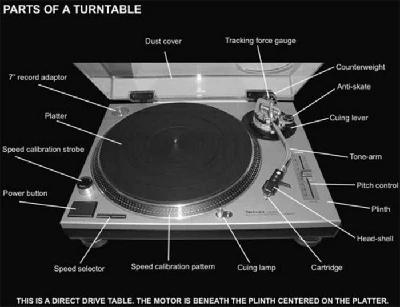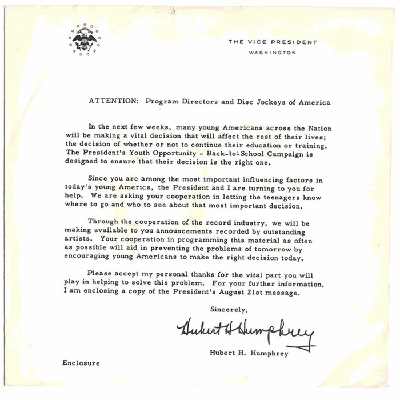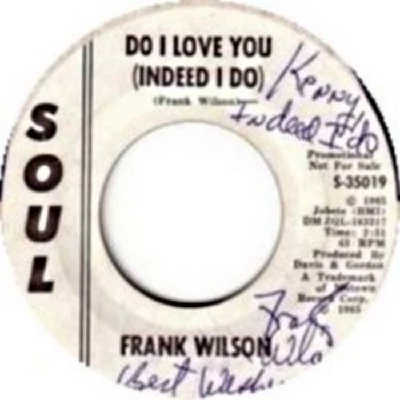Miscellaneous
-
Planet Vinyl A Natural History Part 2
published: 30 /
6 /
2017

In last month's Vinyl Stories we took ourselves from the very start of the record to the point of vinyl's world domination. In part two of Dave Goodwin's journey into this rise of the vinyl record he examines the trends and fortunes of in-demand records with the help of an old friend called Jimmy
Article
Welcome to Vinyl Stories: a natural history, part 2 - The Golden Years
The record has over the years taken many forms, varying its size and the speed at which it spins. The first record of any note was the 78 which was manufactured until the late 1950s and which spun at 78 revolutions per minute (rpm). The trouble with this was that they only carried about five minutes of sound. These fragile records were made with shellac and I still have a few left in my collection.
These were the heavy ones and the record when tapped sounded like metal, but was surprisingly brittle. During this time the 33rpm record was successfully introduced. First produced in 1948, 33s or LPs (long player) rotated at 33 and one-third revolutions per minute, playing for about 25 minutes per side. This is the point of time all record people pay homage to because the record was then made of polyvinyl chloride (PVC), the birth of what we now lovingly call today "vinyl". But wait: the best was yet to come! In 1949 a record of only seven inches in diameter turned up, which just held enough groove on it for one track per side, which meant it became known as the 'single'.
For almost a century the record player was the most common way to listen to recorded music, speeches, lessons and more. The design has been refined over the years but the concept changed little and the basic parts have remained the same since 1948.
If we dissect the instrument on which we play our beloved vinyl we start to have a better understanding of the marvellous way it works. The turntable is the circular platter on which the record sits. A rod positioned in the centre holds the record in place. Without the hole in the record it would be flying about all over the place or played miss-centred and sounding like a really bad pub singer on a Friday night. The metal turntable is covered in rubber or plastic or even your own decorative symbol or slogan. Mine was black with a white outline of the Northern Soul 'keep the faith' fist on it.
NERD ALERT! This is called a slipmat, designed to protect the record from being scratched on the bare turntable. The turntable rotates or spins with the help of either a belt-drive or direct-drive system. The stylus or needle (I don't know why but I find myself stopping just before saying the word 'needle', putting my little finger into the corner of my mouth and instead of saying 'Evil' saying 'needle')... sorry, yes, the needle is the smallest and perhaps the most important component of the record player. It is made from a diamond or other hard material, shaped like a cone and suspended by a flexible strip of metal. The pointed end is the only piece that touches the surface of the record and it rides around the spiralling grooves of the disk, picking up the vibrations which are ultimately turned back into sound.
Remember the photo in the first part of this history? The point of the needle rides around in the groove that you saw in the photo. The stylus sits at one end of the tone arm, and it moves inwards as it goes around the spiral groove. Pretty simple, I hear you shout. Here's the clever bit: as all this happens, the vibrations travel along a flexible metal strip housed in the tone arm which leads to the cartridge in the end. This receives the vibrations which are converted to electrical signals through a coil in a magnetic field. The electric signals are carried along wires to the amplifier which enhances the power of the signal. Finally, the signals are converted back to sounds that come out through the speakers. It sounds pretty complicated but the process is quite simple.
Back in the day records were mainly recorded in monophonic, meaning all of the sound signals are combined and come through one speaker or channel. Again, another major breakthrough in 1958 with the introduction of stereophonic sound systems. This richer, more lifelike sound came from two sets of sound waves recorded and when played, the vibrations travel simultaneously along two different channels and are converted and dispersed through two different speakers. Some singles of that time had the same track on both sides but one was the mono recording and the other was the stereo. I have recently got into refurbishing Dansette record players which have a flip over needle on them which has on one side a 45 and the other says 78. The 45 would be the stereo side and the 78 would be the mono side. What's the difference, Dave? Well, I'm glad you asked because this is my favourite bit of the whole article - the needle in the groove of a mono recording just went left and right as it travelled along but the stereo also went up and down so the needle had to be made of something else to accommodate this. Terriffique!
So just for a minute lets go back to Jimmy, my choice of 45 from my record box. The problem with playing your record was that and still is that every time you play it you are depreciating it not just in value but in sound quality. All the troughs and peaks in the groove in the photo are being worn down and also the needle on the record player is wearing out too. Bummer!
Why am I telling you this? Well it has some bearing on what we are about to discover about Jimmy. When Jimmy was made he was made in batches of 50, 75, or 100 and so on. Jimmy was made as a DEMO or PROMO first in batches of a certain amount. These demos were then sent out to local radio stations for DJs to plug or to champion to get an idea of whether it would do well as a single or just to get airplay before it came out as a fully fledged single.
Sometimes, however, these promos were made with more units than the actual single was made. So a track could have had 500 promos sent out because they thought it was a surefire hit but only 50 actual records pressed and sold because it flopped as a promo. If you look at records today, especially in the Northern Soul genre, some promos can be worth five, 10, 20 or 50 times more than the 'real' pressing or vice versa depending on the amount of discs made. But that's not just it. Its more complicated than that.
Some of these promos never even saw the light of day, and languished in the record company vaults never to see a needle or stylus. The prime example of this was the discovery of an original copy of Frank Wilson's version of 'Do I Love You (Indeed I Do)' on the Motown subsidiary label Soul. Now, at the time, everyone thought the copies had been burned by Berry Gordy after he and Frank had had a bust-up over the rights for it. Years later a copy was unearthed and eventually sold in the 1990s for over £15,000. Then a few years later another one appeared. Both in today's climate are now worth a small fortune as are many other records.
But back to Jimmy. When I picked up Jimmy in the 90s I paid £200 for him. He is a demo on large record label called Columbia but he is different to the original record because he is credited to "The Youth Opportunities Scheme and Jimmy Fraser" instead of just "Jimmy Fraser". Today he is worth around double what I paid for him back then because he is in mint condition. Had he been played to death - and as we heard earlier, depreciated - he might now only be worth what I paid for him back then.
So between Jimmy's birth back in '66/'67, where has he been and who has he belonged to? Who he belonged to we might never know. He may have been in the record company vaults for a while before someone had a clearout and sent them to a local record warehouse. These were big in the 70s and 80s and still are for that matter but the owners of these stores especially in the States have got wise to us soul-mad Brits flying over, sifting through the best bits and flying back with caseloads of goodies to sell here. That could be how Jimmy got to these shores - in fact, that is the best bet. From there he may have been picked up by a dealer in this country and sold in one of the many record fairs, which again were big in the 70s and 80s. Big leisure centre rooms would be hired to house hundreds of record dealers to put up stalls selling nothing but lovely vinyl. It sounds like heaven, eh? Jimmy could well have found his way on to one of these stalls and sold to a collector or even another dealer.
Jimmy might also have found his way into a dealer's record box and as is more likely with more sought-after gems sold at an all-nighter or soul night somewhere. Northern Soul venues, whether it was a full 'nighter or just a normal midnight finish, usually had a quiet room where you could go to chill out, chat or cool down, In these rooms you would find the strange chewing-gum-laden chaps with various record boxes selling vinyl. For me it was one of the best times to pick up records because you could barter with the seller and usually he was off his tits on some kind of class-A drug so you could usually pick up a bargain.
As it happens I picked up Jimmy at a record fair in Leicester at the old Grace Road Leisure Centre, I think. Another good way to pick up vinyl like Jimmy was on specialised record lists. Back in the day dealers would put all their vinyl on to a list and send it out by post. If you paid a small fee some of them even had their own CD with sound clips of them on it so you could sample the record first. Of course nowadays it's easier to trace your sought-after vinyl with the advent of the internet. Soul-wise there are many dealers out there that used to send out sales lists that now advertise on their own website and many just sell on eBay.
A lot of records, especially in the Northern Soul circle, go for different prices depending on demand too. This might sound a bit strange but if you bear in mind the Northern Soul scene has been ongoing since the 60s and records have been discovered and uncovered ever since and are still being discovered to this day. Take a track like Jimmy which was big in demand and played a hell of a lot at Saint Ives Soul nights/nighters in the mid to late 1970s. Prices then would have been relatively high due to the demand of the record (there may have been only 500 pressed).
Prices then drop off as fashions change, but some DJ starts playing it again in the late 90s and where the price before may have been £200 for a demo copy, now because of the airplay and the demand, everyone wants a copy again and it could rise to double that or even more.
So Jimmy has found his way into my record box and sometimes sees the light of day but I don't play him anymore except for very special occasions. Because of this and the high price you would have to shell out for your must-have 45, naughty record makers used to make bootleg copies of the same track, mostly however taken from a dodgy recording, and sell them cheap to folk that could afford them. The DJs quickly picked up on this and started buying them so they could play them all the time at nighters and amazingly these bootlegs have also become sought-after too in their own way.
Just before we go and venture into the last part of this article I did some digging into Jimmy a while ago and the story is quite fascinating. The record should have been released on October 11, 1965 as part of a campaign led by the then Vice President of the USA in a bid to get the youth of America off the streets and off drugs and back into schools and getting an education. There was a letter with each copy that was to be given out to buyers.
Then just before they were going to release it under the Youth Opportunities Program they decided, having the backing of a very big name in the boxing world to endorse it and help it circulate it, to release it under the credit of Jimmy Fraser. As we saw, some of the copies had already been pressed by this time so some of the copies are credited to the YOP and some to Jimmy Fraser. I'm told my copy is the rarer of the two but I'm also told that they made a few stock copies at the time ready to sell but withdrew it shortly after so the stock copy which has a red label is as rare as rare comes. Marvellous!
Picture Gallery:-

